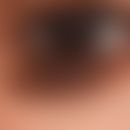DefinitionThis section has been translated automatically.
Follicular mucinous hamartoma (follicular mucinous nevus) is a rare, congenital or acquired in the first months of life, benign, asymptomatic, epithelial malformation (there are < 30 reports of "follicular epidermal nevi" in the literature; Lepage W et al. 2016). The epithelial malformation is characterized by a plaque arranged in the Blaschko lines, dissected in its surface, which is composed of solid follicular, keratotic papules. Histologically, the finding is characterized by mucinous changes that affect the follicular epithelia, but may also affect the parafollicular connective tissue.
Differential diagnosisThis section has been translated automatically.
Mucinous hamartoma: Histologically there is no evidence of follicular mucinosis; mucin dermally located.
Mucinous eccrine nevus: Histologically, the mucinous reaction is limited to the eccrine sweat glands.
You might also be interested in
Progression/forecastThis section has been translated automatically.
Benign
Note(s)This section has been translated automatically.
"Follicular mucinosis" is characterized by a general histopathological reaction pattern in the follicular epithelium. Follicular mucinous transformation is a feature of alopecia mucinosa, but can occur in a variety of different diseases. All cases of epidermal nevi with mucinous deposits described so far are referred to as mucinous nevus or mucinous eccrine nevus; in the first type of disease, diffuse mucinous deposits are seen only in the papillary dermis, and in the second type, the mucin is found around the eccrine structures.
Case report(s)This section has been translated automatically.
A 17-year-old boy was found to have a 10 x 6 cm brown, non-itching plaque on the right side of his neck that had "always" existed and had a blaschkoid configuration. This consisted of tight, firm follicular papules. Dermatoscopy revealed perifollicular hypopigmentation and geometric brown structures. Histopathologic examination revealed hyperkeratosis, acanthosis, papillomatosis and follicular and perifollicular mucinosis. Biopsy showed pore dilatation of the hair follicles and fibromucinous stroma in the papillary and perifollicular dermis. In the perifollicular dermis, mucinous material was found between fibroblasts. Staining with Alcian blue at pH 2.5 showed not only diffuse deposits of amorphous material in the papillary dermis, but also deposits in the perifollicular dermis. Elastica van Gieson staining showed an absence of collagen and elastic fibers in the area of mucin deposits and normal collagen and elastic fibers in the unaffected papillary dermis (Oiso N et al. 2014).
LiteratureThis section has been translated automatically.
- Lepage W et al (2016) Mucinous nevus of late onset. Ann Dermatol Venereol 143:547-553.
- Oiso N et al (2014) Follicular mucinous nevus: a possible new variant of mucinous nevus. J Am Acad Dermatol 71:e141-e1422.
- Redondo Bellón P et al (1993) .mucinous nevus. J Am Acad Dermatol 28: 797-798.
- Robles-Tenorio A et al (2022) Combined epidermal-follicular mucinous nevus: dermoscopic appearance. Dermatol Pract Concept12:e2022043
- Tadini G et al (2013) Nevoid follicular mucinosis: a new type of hair follicle nevus. J Cutan Pathol 40:844-847.
Outgoing links (1)
Mucinous nevus;Disclaimer
Please ask your physician for a reliable diagnosis. This website is only meant as a reference.







